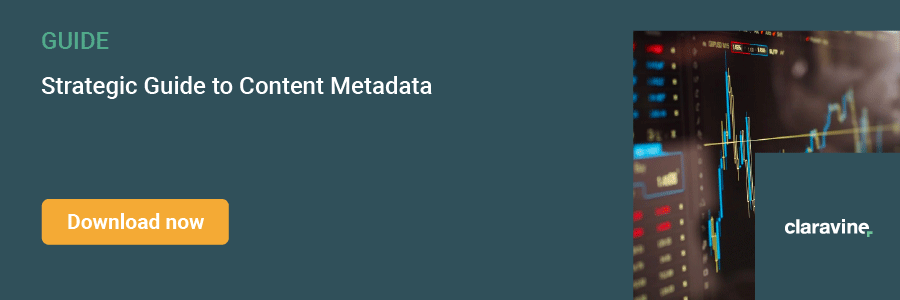How to Build a Data-Driven Content Strategy

Any modern marketer knows that data is critical to their success. From analyzing performance to serving up dynamic customer experiences across digital properties, data becomes more integral to our day-to-day operations with every passing year. But data is more than a real-time bellwether: It’s also an essential part of the long-term strategic planning process.
Often, when we think about “data,” we’re thinking primarily about metrics. Downloads, clicks, and views; open rates and bounce rates; the list of performance statistics we track goes on and on. As it should! These content metrics are crucial for assessing and informing marketing strategy. But they can become even more powerful when considered in the context of a second layer of information: content metadata.
As it turns out, content metadata can be a whole lot more than the sets of tags that keep teams organized and allow for streamlined development and personalized distribution. Used right, content metadata can be a secret weapon to enhance your strategic planning. By using metadata to consider what your content looks like, who it’s for, and where it’s being used, strategists can gather invaluable context that allows them to hear the full story their metrics are telling—and use that insight to plan and prioritize better.
Trust me: There’s a lot more strategic insight to be gleaned from your content’s metadata than you think. In fact, there are four key ways marketing teams can plan better using the data attached to their existing content library.
1. Identify Coverage Gaps to Spot Customer Experience Breakdowns
Types of metadata to consider:
- Persona
- Industry
- Buying stage
- Language
- Geography
- Product line
- Content type
The best way to kick off a strategic planning session is with two foundational questions:
- What do we have?
- What are we missing?
Fundamentally, what you’re asking here is: How good of a job is our marketing content doing today to facilitate positive customer experiences, and how can we make it better?
We ask these questions because customer experience is built on consistency. Prospects and customers must be guided through their interactions with consistent, relevant messaging tailored to who they are and what they need at each stage of their journeys. The ability (or lack thereof) of your organization to deliver a smooth customer experience can make or break your brand.
To get a clearer look at how well you’re delivering consistent customer experiences, you’ll need to take a big-picture view of your content coverage and identify your existing coverage gaps.
Put simply, a coverage gap is a point in the customer journey that is inadequately supported by your existing content library. A coverage gap might look like:
- A lack of material for a key persona in the “consideration” phase of the customer journey
- An underserved geography or language
- Insufficient sales material for a particular product line or use case
Because there are so many different customer journeys (unique depending on who a customer is, where they’re from, what problem they’re looking to solve, etc.), you’ll want to slice and dice your metadata views in a variety of different ways to get a full understanding of where communication may be breaking down.
Consider starting by mapping your content inventory across the stages of the buying cycle, then viewing that cycle from a variety of perspectives. What content do you have for your key personas at each stage of the buy cycle? What about for your various target geographies? Product lines? Next, you can drill down into specific areas that warrant a closer look based on your company and your priorities. For example, you may want to map your language coverage across key personas to see whether there are holes that could be costing you business.
Scouring content coverage tables for potential gaps may not sound as glamorous as whiteboarding new ambitious projects, but it’s an absolutely essential step to take in order to understand the state of your current customer experience and spot the areas that need work. It takes just one slipup to poison an otherwise flawless experience and lose a customer, so it’s crucial to pinpoint the places where gaps exist and make filling them a priority.
2. Connect Metadata to Performance to Identify Trends
Types of metadata to consider:
- Word count
- Video length
- SEO keywords
- Publication channel
- Messaging
- Offers
Like any good marketer, you already track plenty of metrics to determine how well individual assets and campaigns perform. The next piece of the puzzle is to extrapolate what those metrics can tell you about your content strategy as a whole. That’s where the content metadata layer comes in.
Content metadata shouldn’t replace your all-important performance metrics, of course. Instead, it should sit above them and provide a secondary layer of objective insight. Rather than philosophizing about the intangibles of a particular campaign or asset, content metadata can uncover the fundamental aspects of content that contribute to its success or failure.
For this exercise, you’ll begin with the performance metrics you’re most interested in, then use content metadata to hunt for trends. Let’s use the company blog as an example. You already know which posts have been your most and least successful over, say, the last year, and you may even have some theories as to what separates the leaders from the laggards. With metadata, you can test these hypotheses by mapping your high and low performers by word count, publication channel, SEO keyword, messaging theme, and more, to see how these variables track against outcomes.
By taking a more elemental approach to performance analysis, you’ll be better equipped to pinpoint exactly which variables are making the biggest impact. Perhaps most importantly, identifying the aspects of content that are having the biggest impact can help you avoid unnecessarily upending existing strategies. Is your blog focused on the wrong subject matter? Or are some posts simply running too long?
3. Identify Assets that can be Reused or Repurposed to Maximize Your Bandwidth
Types of metadata to consider:
- SEO keyword
- Messaging
- Theme
- Persona
Any good planning session will generate more quality ideas than can possibly be brought to life. Ultimately, some number of potential projects must be left on the cutting-room floor, simply because the team has limited time and resources with which to tackle them.
But thoughtful use of content metadata can free up a significant chunk of future bandwidth and make room for more game-changing projects. How? By identifying existing assets and campaigns from which you can borrow for future projects. It’s almost like someone’s already done a portion of the work for you—because they have!
As you identify your priority projects, use metadata filtering to help search your existing content library. Have you tackled this topic before? What ad campaigns have you run in the past for this product line? More often than not, you’ll find assets that already exist from which you can either pull elements or repurpose entirely for your new needs.
By borrowing and adapting existing material, you’ll lessen the strain on your content creators and open up their availability to focus more time on net-new projects that need to be tackled from scratch. Not to mention, by reusing existing material, you’ll make it easier to ensure new assets and campaigns align with the kind of consistent messaging that makes for smoother, more positive customer experiences.
4. Prepare for Content that Will Need to be Removed or Replaced
Types of metadata to consider:
- Expiration date
- Publish date
- Messaging theme
In addition to considering the new content you’ll provide your customers, prospects, and internal teams, your strategic planning should also take into account what you’ll need to do with existing content that is—or will soon be—out of date. Planning teams should ask:
- What content will no longer be relevant or up-to-date in the near future?
- What content will need to be removed from digital properties and internal repositories?
- What content will need to be replaced or refreshed?
Whether content is stale because your messaging or visual branding has changed or it’s simply irrelevant due to an expiring offer, decommissioned product, or a changed situation, your team should be prepared to deal with each asset in a timely manner and fill any gaps left in its absence.
For each outdated asset you identify, you’ll need to decide whether it should be:
- Removed without being replaced
- Refreshed to reflect new information, branding, messaging, or offers
- Removed and replaced
For each answer of b) or c), you’ll need to build said refreshing/replacing of aging assets into your strategic content plan. By doing so, you’ll tackle potential coverage gaps before they happen, as well as reduce the number of ad hoc projects that could end up blowing up other timelines down the road.
Takeaways
Content metadata isn’t just there to keep systems running smoothly and make content easy to find: It’s also a powerful asset when it comes to building an effective content strategy. By adding layers through which to assess content variables, identify gaps in coverage, and maximize your resources, metadata can lend a much-needed scientific lens to the project of prioritization.
Happy planning!




